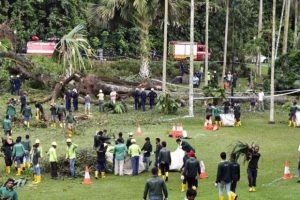SINGAPORE – The National Parks Board (NParks) has completed a check of all the trees in Palm Valley in the Singapore Botanic Gardens and they are safe, it said in an update on Sunday (Feb 12).
A 40m-tall Tembusu tree that was more than 270 years old fell on Saturday, killing one woman and injuring four others.
 A 38-year-old woman, an Indian national, died while her husband, who is French, was hurt. Their two children, both one, and a 26-year-old Singaporean woman were also injured.”NParks is deeply saddened by the tree fall incident at the Singapore Botanic Gardens. Our thoughts are with the family of the deceased and we will render whatever assistance possible to them,” said Dr Leong Chee Chiew, commissioner of parks and recreation.
A 38-year-old woman, an Indian national, died while her husband, who is French, was hurt. Their two children, both one, and a 26-year-old Singaporean woman were also injured.”NParks is deeply saddened by the tree fall incident at the Singapore Botanic Gardens. Our thoughts are with the family of the deceased and we will render whatever assistance possible to them,” said Dr Leong Chee Chiew, commissioner of parks and recreation.
Dr Leong said that NParks shares the public’s concerns about the safety of the trees in the Botanic Gardens “especially in view of the recent spate of intense weather conditions”.
“We are also in the midst of conducting more checks for trees in the vicinity of the Palm Valley (such as the Rainforest) and all the Heritage Trees in the Gardens.”
Palm Valley remains closed to the public access while the rest of the Gardens remains open.
The tree was last inspected in September 2016 and was found to be healthy.
As a heritage tree, the Tembusu was inspected twice a year, a higher frequency than other trees in the Gardens, NParks said.
This includes checks on the root collar, anchoring roots, crown, trunk and signs of soil movement.
The tree was also protected by a lightning conductor and fenced off to prevent compaction of its root zone by visitors. Leaf litter is routinely applied to the root zone to encourage healthy root growth, NParks said.
Dr Leong also listed the various measures NParks has taken to monitor and manage the trees.
“NParks has a comprehensive tree management programme that includes a rigorous regime of inspections and pruning,” he said.
“We have also taken an adaptive approach and instituted more stringent measures over time in response to unpredictable and severe weather patterns.”
NParks has increased the frequency of inspections for trees along expressways and major roads due to increasingly unpredictable and severe weather conditions, it said.
Since 2012, the inspections were conducted every six to 12 months, instead of 12 to 18 months.
The checks are based on the tree care standards prescribed by the International Society of Arboriculture.
In addition, old trees of more than 4m in girth have got a detailed second-level inspection since November last year.
“Besides inspections, we have also been taking measures to improve the general health of our trees,” Dr Leong said.
These include routine mulching to supplement the regular application of fertilisers, and pruning techniques to improve the structure and balance of trees.
From May last year, NParks has also pruned trees before periods of more severe weather conditions.
“Going forward, we are already developing modelling techniques to better understand the structural behaviour of trees under varying environmental conditions like rain, wind and soil,” he added.
Dr Leong also urged the public not to speculate on the cause of the tree fall as it is still under investigation.